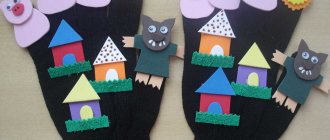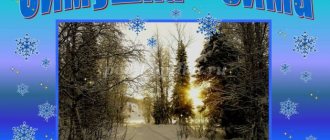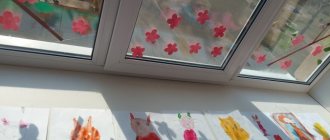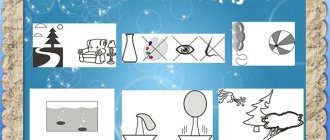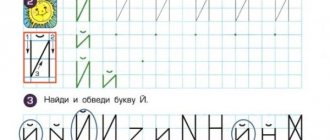MAGAZINE Preschooler.RF
CARD FILE ON PSYCHOGYMNASTICS"Fight"
Goal: Relax the muscles of the lower face and hands.
“You and your friend had a fight. A fight is about to start. Take a deep breath and clench your jaw tightly. Fix your fingers in your fists, press your fingers into your palms until it hurts. Hold your breath for a few seconds. Think about it: maybe it’s not worth fighting? Exhale and relax. Hooray! The troubles are over!
This exercise is useful to carry out not only with anxious, but also with aggressive children.
"Air balloons"
Goal: Relieve tension, calm children.
All players stand or sit in a circle. The presenter gives instructions: “Imagine that now you and I will inflate balloons. Inhale the air, bring an imaginary balloon to your lips and, puffing out your cheeks, slowly inflate it through parted lips. Follow with your eyes how your ball becomes bigger and bigger, how the patterns on it increase and grow. Introduced? I also imagined your huge balls. Blow carefully so that the balloon does not burst. Now show them to each other .
The exercise can be repeated 3 times.
"The Ship and the Wind"
Goal: To get the group into a working mood, especially if the children are tired.
“Imagine that our sailboat is sailing on the waves, but suddenly it stops. Let's help him and invite the wind to help. Inhale the air, draw in your cheeks strongly... Now exhale noisily through your mouth, and let the released wind propel the boat. Let's try again. I want to hear the wind roar!”
The exercise can be repeated 3 times.
"Gift Under the Tree"
Goal: Relaxation of facial muscles, especially around the eyes.
“Imagine that the New Year holiday is coming soon. You've been dreaming about a wonderful gift for a whole year. So you approach the Christmas tree, close your eyes tightly and take a deep breath. Hold your breath. What lies under the tree? Now exhale and open your eyes. Oh, miracle! The long-awaited toy is in front of you! You are happy? Smile" .
After completing the exercise, you can discuss (if the children want) who dreams of what.
"Dudochka"
Goal: Relaxation of facial muscles, especially around the lips.
“Let's play the pipe. Take a shallow breath of air and bring the pipe to your lips. Start exhaling slowly, and as you exhale, try to stretch your lips into a tube. Then start over. Play! What a wonderful orchestra!”
All of the exercises listed can be done in the classroom, sitting or standing at a desk.
"Dancing Hands"
Purpose: If children are restless or upset, this game will give children (especially upset, restless) the opportunity to clarify their feelings and relax internally.
“Lay out large sheets of wrapping paper (or old wallpaper) on the floor. Take 2 crayons each. Choose a crayon color you like for each hand. Now lie with your back on the laid out paper so that your arms, from hand to elbow, are above the paper. (In other words, so that the children have room to draw.) Close your eyes, and when the music starts, you can use both hands to draw on the paper. Move your hands to the beat of the music. Then you can see what happened” (2-3 minutes). The game is played to music.
"Blind Dance"
Goal: Develop trust in each other, relieve excess muscle tension.
“Get into pairs. One of you gets a blindfold, he will be “blind”. The other will remain “sighted” and will be able to drive the “blind”. Now hold hands and dance with each other to light music (1-2 minutes). Now switch roles" .
First, you can sit the children in pairs and ask them to hold hands. The one who sees moves his hands to the music, and the blindfolded child tries to repeat these movements without letting go of his hands for 1-2 minutes. Then the children change roles. If an anxious child refuses to close his eyes, reassure him and do not insist. Let him dance with his eyes open.
"Caterpillar"
Purpose: The game teaches trust.
The success of everyone’s promotion depends on everyone’s ability to coordinate their efforts with the actions of other participants. “Guys, now you and I will be one big caterpillar and we will all move around this room together. Form a line, place your hands on the shoulders of the person in front. Place a balloon or ball between the stomach of one player and the back of the other. Touching the balloon (ball) with your hands is strictly prohibited! The first participant in the chain holds his ball at outstretched arms. Thus, in a single chain, but without the help of hands, you must follow a certain route .
"Change of Rhythms"
Goal: To help anxious children join the general rhythm of work and relieve excessive muscle tension.
If the teacher wants to attract the attention of the children, he begins to clap his hands and count loudly, in time with the clapping: one, two, three, four... The children join in, too, all clapping their hands together, counting in unison: one, two, three, four ... Gradually the teacher, and after him the children, 1 claps less and less, counts more and more quietly and slowly.
"Bunnies and Elephants"
Goal: To enable children to feel strong and courageous, to help increase self-esteem.
“Guys, I want to offer you a game called “Bunnies and Elephants.” At first, you and I will be little bunnies. Tell me, when a hare feels danger, what does it do? That's right, he's shaking. Show him how he shakes. He purses his ears, shrinks all over, tries to become small and unnoticeable, his tail and paws are shaking,” etc. Children show. “Show me what bunnies do if they hear a person’s steps?” Children scatter around the group, class, hide, etc. “What do bunnies do if they see a wolf?..” The teacher plays with the children for several minutes.
“And now you and I will be elephants, big, strong, brave. Show how calmly, measuredly, majestically and fearlessly elephants walk. What do elephants do when they see a person? Are they afraid of him? No. They are friends with him and, when they see him, they calmly continue on their way. Show me how. Show what elephants do when they see a tiger...” Children pretend to be a fearless elephant for a few minutes.
After the exercise, the guys sit in a circle and discuss who they liked to be and why.
"Magic Chair"
Goal: To help increase the child’s self-esteem and improve relationships between children.
This game can be played with a group of children for a long time. First, an adult must find out the “history” of each child’s name - its origin, what it means. In addition, you need to make a crown and a “Magic Chair” - it must be high. The adult has a short introductory conversation about the origin of names, and then says that he will talk about the names of all the children in the group (the group should not be more than 5-6 people), and it is better to name the names of anxious children in the middle of the game. The one whose name is told becomes the king. Throughout the entire story about his name, he sits on a throne wearing a crown.
At the end of the game, you can invite the children to come up with different versions of his name (gentle, affectionate). You can also take turns saying something good about the king.
Muscle relaxation studies
"Bar 1"
Goal: Relax your back muscles.
Now you and I will be weightlifters. Imagine that there is a heavy barbell lying on the floor. Inhale, lift the barbell off the floor with your arms outstretched, and lift it. Very hard. Exhale, place the barbell on the floor, and rest. Let's try again".
"Bar 2"
Goal: To relax the muscles of the arms and back, to enable the child to feel successful.
“Now let’s take a lighter barbell and lift it above our heads. You took a breath, raised the barbell, and fixed this position so that the judges counted your victory. It’s hard to stand like that, drop the barbell, exhale. Relax. Hooray! You are all champions. You can bow to the audience. Everyone is clapping for you, bow again like champions.” .
The exercise can be performed several times.
"Icicle"
Goal: Relax the arm muscles.
“Guys, I want to ask you a riddle:
There is a white nail hanging under our roof, the sun will rise, the nail will fall. (V. Seliverstov)
That's right, it's an icicle. Let's imagine that we are artists and are staging a play for kids. The announcer (that's me) reads this riddle to them, and you will pretend to be icicles. When I read the first two lines, you will inhale and raise your arms above your head, and on the third, fourth, drop your relaxed arms down. So, we rehearse... And now we perform. It turned out great!”
"Humpty Dumpty"
Goal: Relax the muscles of the arms, back and chest.
“Let's put on another little performance. It's called "Humpty Dumpty". Humpty Dumpty was sitting on the wall. Humpty Dumpty fell in his sleep. (S. Marshak)
First, we will turn the body left and right, while the arms dangle freely, like a rag doll. To the words “fell in my sleep,” we sharply tilt the body down.”
"Screw"
Goal: Remove muscle tension in the shoulder girdle area.
“Guys, let's try to turn into a screw. To do this, place your heels and toes together. At my command “Start” we will turn the body first to the left, then to the right. At the same time, your arms will freely follow your body in the same direction. Let’s start!.. Stop!”
The etude can be accompanied by the music of N. Rimsky-Kor-sakov “Dance of the Buffoons” from the opera “The Snow Maiden” .
"Pump and Ball"
Goal: Relax as many muscles in your body as possible.
“Guys, break into pairs. One of you is a large inflatable ball, the other one inflates this ball with a pump. The ball stands with the whole body limp, on half-bent legs, arms and neck relaxed. The body is tilted slightly forward, the head is lowered (the ball is not filled with air). The friend begins to inflate the ball, accompanying the movement of his hands (they pump the air) with the sound “s”. With each supply of air, the ball inflates more and more. Hearing the first sound “s”, he inhales a portion of air, simultaneously straightening his legs at the knees; after the second “s”, his torso straightens; after the third, the ball’s head rises; after the fourth, his cheeks puff up and even his arms move away from his sides. The ball is inflated. The pump stopped pumping. A friend pulls the pump hose out of the ball... Air comes out of the ball with force with the sound “sh”. The body went limp again and returned to its original position . Then the players change roles.
| Next > |
CARD FILE ON PSYCHOGYMNASTICS
"Fight"
Goal : Relax the muscles of the lower face and hands.
“You and your friend had a fight. A fight is about to start. Take a deep breath and clench your jaw tightly. Fix your fingers in your fists, press your fingers into your palms until it hurts. Hold your breath for a few seconds. Think about it: maybe it’s not worth fighting? Exhale and relax. Hooray! The troubles are over!
This exercise is useful to carry out not only with anxious, but also with aggressive children.
"Air balloons"
Goal : Relieve tension, calm children.
All players stand or sit in a circle. The presenter gives instructions: “Imagine that now you and I will inflate balloons. Inhale the air, bring an imaginary balloon to your lips and, puffing out your cheeks, slowly inflate it through parted lips. Follow with your eyes how your ball becomes bigger and bigger, how the patterns on it increase and grow. Introduced? I also imagined your huge balls. Blow carefully so that the balloon does not burst. Now show them to each other.”
The exercise can be repeated 3 times.
"The Ship and the Wind"
Goal : Set the group up for work, especially if the children
are tired.
“Imagine that our sailboat is sailing on the waves, but suddenly it stops. Let's help him and invite the wind to help. Inhale the air, draw in your cheeks strongly... Now exhale noisily through your mouth, and let the released wind propel the boat. Let's try again. I want to hear the wind roar!”
The exercise can be repeated 3 times.
"Gift Under the Tree"
Goal : Relaxation of facial muscles, especially around the eyes.
“Imagine that the New Year holiday is coming soon. For a whole year we dreamed of a wonderful gift. So you approach the Christmas tree, close your eyes tightly and take a deep breath. Hold your breath. What lies under the tree? Now exhale and open your eyes. Oh, miracle! The long-awaited toy is in front of you! You are happy? Smile."
After completing the exercise, you can discuss (if the children want) who dreams of what.
"Dudochka"
Goal : Relaxation of facial muscles, especially around the lips.
“Let's play the pipe. Take a shallow breath of air and bring the pipe to your lips. Start exhaling slowly, and as you exhale, try to stretch your lips into a tube. Then start over. Play! What a wonderful orchestra!”
All of the exercises listed can be done in the classroom, sitting or standing at a desk.
"Dancing Hands"
Target:
If children are restless or upset, this game will give children (especially upset, restless) the opportunity to clarify their feelings and relax internally.
“Lay out large sheets of wrapping paper (or old wallpaper) on the floor. Take 2 crayons each. Choose a crayon color you like for each hand. Now lie with your back on the laid out paper so that your arms, from hand to elbow, are above the paper. (In other words, so that the children have room to draw.) Close your eyes, and when the music starts, you can use both hands to draw on the paper. Move your hands to the beat of the music. Then you can see what happened” (2-3 minutes). The game is played to music.
Summary of GCD with elements of psycho-gymnastics in the middle group. Walk in the autumn forest
Abstract of the educational activity in the middle group “Walk in the autumn forest”
Author: Volodina Elena Aleksandrovna teacher Place of work: MBDOU TsRR d/s No. 10 Description:
This abstract can be useful for educators, teachers of additional education and is designed for children of the middle group.
Goal: to teach children to emotionally color their actions. Objectives: learn to focus on internal sensations, muscle tension and relaxation; consolidate knowledge about the signs of autumn, teach children to recognize and name leaves from different trees; to cultivate friendly relations in the children's team, the desire to be attentive and polite. Progress of the lesson: The teacher invites the children to go on a trip to the autumn forest. Children and teacher (together): One, two, three, four, five - Let’s go for a walk in the forest now. The teacher puts on a cape and a wreath of autumn leaves. Enter the “forest” (scenery). Educator: -Children, I am Autumn, I invite you to take a walk through the autumn forest. (Depicts a blow of the wind). -Children, the wind whirled us in the air, lifted us along with the leaves (take different leaves) high into the sky and we fly, slowly landing on the grass. (The teacher imitates the movements with the children “Waltz of Autumn Leaves”) Educator : -But we don’t children, and colorful autumn leaves from different trees! (Asks the children what tree they are leaves from. Children : - from maple, from linden, from birch, from oak. Educator : -What color are the leaves? Children: -Yellow, orange, red.) Educator : -What beautiful leaves you are !Let's play with you. Game “Find your house” One, two, three, four, five - We will collect leaves. We will collect birch leaves, rowan leaves, poplar leaves, aspen leaves, oak leaves, we will take an autumn bouquet to the forest. (After these words, the children must find the tree corresponding to the selected leaf). Educator : - Suddenly a strong wind blew! (Invites the children to blow like the wind). Our bouquet scattered, the leaves swirled in the air. - You, leaves, will spin, scatter in all directions! Educator : - Look how beautiful it has become in the forest! What is the name of the phenomenon when leaves fall? Children : - Leaf fall. Educator : - The naughty wind has collected a whole carpet from leaves. What is it like? Children : - Bright, colorful, colored, gold. Game “Give a leaf to a friend” (condition: you need to give a leaf to someone who has not yet been given it. Don’t forget to thank for the gift). Gymnastics. The teacher invites the children to go to the clearing. (Toy hares are sitting in the clearing). -Who do we see in the clearing? (Zaitsev). What are they doing? (playing). Let's play with them. (Children stand in a circle and pretend to “beat the drums,” then stomp their feet and jump like bunnies). Educator: - What is this? Did the branches crack? Yes, these little bear cubs wrapped their paws around their knees, pressed them to their tummy and swayed like on a swing. (Children perform the appropriate movements). They were so naughty, they were having fun. (Children laugh). We got pumped up and tired! We turned over on our tummies, put our heads in our hands and dangled our legs. (Children do this). Educator : - It’s gotten cold in the forest. (Imitate). How can we keep warm? Children : - Let's light a fire. Educator : - But you can’t light a fire in the forest so as not to harm its inhabitants? I propose to light a fire of kindness. (They hold hands, stand in a circle, “transfer” the warmth of their hearts to each other through a handshake, with the words: “I convey the warmth of my heart and smile to your friend and his smile lights up"). Educator: -Now let’s raise our hands up, come closer to each other, in a tight circle. Do you feel how hot the flame is? (Yes). Are you warm? (Yes). Educator : - The time has come to return to kindergarten. But we will take with us a piece of the warmth given to each other. We will keep it and lead a round dance: A strong friendship will not break, It will not fall apart from rains and blizzards. He won’t leave a friend in trouble, he won’t ask too much! This is what it means - a true faithful friend! (They say goodbye to Autumn). Children and teacher together: - One, two - turn around, Three, four - spin. Come back to the group together! (The teacher takes off Autumn’s clothes). Educator : - Did you like the walk through the autumn forest? What did you like most? What do you remember? (Children’s answers).
We recommend watching:
Summary of GCD in the middle group “Russian Izba” Plan of GCD for children of the middle group. Wild animals GCD outline for children of the middle group. My Motherland A story about autumn for preschoolers
Similar articles:
Summary of lessons in kindergarten in the middle group. Profession rescuer
Lesson in the middle group of kindergarten. Professions of rural people
Lesson on speech development “Journey to the forest”. Middle group
